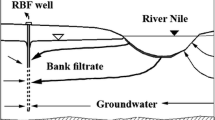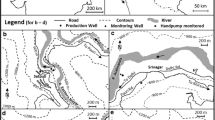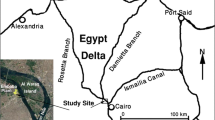Abstract
In the densely populated semi-arid territory around Delhi, the water demand is rising continuously, while the surface- and groundwater resources are threatened by contamination and overexploitation. This is a typical scenario in many newly industrialising and developing countries, where new approaches for a responsible resources management have to be found. Bank filtration holds a great potential, thus being a low tech method and benefiting from the storage and contaminant attenuation capacity of the natural soil/rock. For this study, three field sites have been constructed to investigate bank filtration in different environments in and around the megacity with a main focus on inorganic contaminants. Hydraulic heads, temperature gradients and hydrochemistry of surface water and groundwater were analysed in three different seasons. Depending on site-specific conditions, distinct hydrogeological conditions were observed and both positive and negative effects on water quality were identified. Most concerning issues are the impact of anthropogenic ammonia, the mixing with ambient saline groundwater and the mobilisation of arsenic during the reductive dissolution of manganese- and iron-(hydr)oxides. Positive aspects are the dilution of contaminants during the mixing of waters from different sources, the sorption of arsenic, denitrification, and the precipitation of fluoride under favourable conditions.









Similar content being viewed by others
References
Acharyya SK (2005) Arsenic levels in groundwater from quaternary alluvium in the Ganga Plain and the Bengal Basin, Indian subcontinent: insights into influence of stratigraphy. Gondwana Res 8(1):55–66
Agarwal T, Khillare PS, Shridhar V (2006) PAHs contamination in bank sediment of the Yamuna River, Delhi, India. Environ Monit Assess 123:151–166
Ambast SK, Tyagi NK, Raul SK (2006) Management of declining groundwater in the Trans Indo-Gangetic Plain (India): some options. Agr Water Manage 82:279–296
Anderson MP (2005) Heat as a ground water tracer. Ground Water 43(6):951–968
Appelo CAJ, Postma D (1993) Geochemistry, groundwater and pollution. Balkema, Rotterdam
Ayoob S, Gupta AK (2006) Fluoride in drinking water: a review on the status and stress effects. Crit Rev Env Sci Tec 36:433–487
Bengtsson G, Annadotter H (1989) Nitrate reduction in a groundwater microcosm determined by 15 N gas chromatography-mass spectrometry. Appl Environ Microb 55(11):2861–2870
BIS (1992) Indian standard specifications for drinking water. IS 10500 1983/1992. The Bureau of Indian Standards (BIS), New Delhi
CGWB (2006) Ground water year book 2005–2006, National Capital Territory, Delhi. Central Ground Water Board, Govt. of India, New Delhi
Champ DR, Gulens J, Jackson RE (1979) Oxidation–reduction sequences in ground water flow systems. Earth Sci 16:12–23
CPCB (2006) Water quality status of River Yamuna (1999-2005). ADSORBS/41/2006-07 Central Pollution Control Board, Govt. of India. Available via http://www.cpcb.nic.in. Cited 15 February 2009
CSE (2007) Sewage canal—how to clean up the Yamuna. Centre for Science and Environment, New Delhi
Daga S (2003) Private supply of water in Delhi. Centre for Civil Society, New Delhi. Available via www.ccsindia.org. Cited 15 September 2008
Das BK, Kakar YP, Moser H, Stichler W (1988) Deuterium and oxygen-18 studies in groundwater of the Delhi area, India. J Hydrol 98:133–146
Dash RR, Mehrotra I, Kumar P, Grischek T (2008) Lake bank filtration at Nainital, India: water-quality evaluation. Hydrogeol J 16:1089–1099
Datta PS, Tyagi SK (2004) Evidences of climatic uncertainties linked groundwater variability in peri-urban agricultural areas of Delhi. In: Proceedings of the 1st Asia Oceania Geosciences Society (AOGS) conference. 5–8 July 2004, Singapore
Datta PS, Bhattacharya SK, Tyagi SK (1996a) 18O studies on recharge of phreatic aquifers and groundwater flow-paths of mixing in Delhi area. J Hydrol 176:25–36
Datta PS, Deb DL, Tyagi SK (1996b) Stable isotope (180) investigations on the processes controlling fluoride contamination of groundwater. J Contam Hydrol 24:85–96
Datta PS, Deb DL, Tyagi SK (1997) Assessment of groundwater contamination from fertilizers in the Delhi area based on 180, NO3 − and K+ composition. J Contam Hydrol 27:249–262
Diham SC (2007) Artificial recharge of aquifers. In: Proceedings of the national groundwater congress. 11 September 2007, New Delhi
Dillon P (2005) Future management of aquifer recharge. Hydrogeol J 13:313–316
Doussan C, Toma A, Pari B, Poitevin G, Ledoux E, Detay M (1994) Coupled use of thermal and hydraulic head data to characterize river–groundwater exchanges. J Hydrol 153:215–229
Doussan C, Poitevin G, Ledoux E, Detay M (1997) River bank filtration: modelling of the changes in water chemistry with emphasis on nitrogen species. J Contam Hydrol 25:129–156
Duff JH, Triska FJ (1999) Nitrogen biochemistry and surface—subsurface exchange in streams. In: Jones JB, Mulholland PJ (eds) Streams and ground waters. Elsevier, New York
Fukada T, Hiscock KM, Dennis PF, Grischek T (2003) A dual isotope approach to identify denitrification in groundwater at a river-bank infiltration site. Water Res 37:3070–3078
Grischek T, Schoenheinz D, Ray C (2002) Siting and design issues for riverbed filtration schemes. In: Ray C, Melin G, Linsky RB (eds) Riverbank filtration. Kluwer, Dordrecht
Grünheid S, Amy G, Jekel M (2005) Removal of bulk dissolved organic carbon (DOC) and trace organic compounds by bank filtration and artificial recharge. Water Res 39:3219–3228
Grützmacher G, Böttcher G, Chorus I, Bartel H (2002) Removal of microcystins by slow sand filtration. Environ Toxicol 17(4):386–394
Heberer T, Mechlinski A, Fanck B, Knappe A, Massmann G, Pekdeger A, Fritz B (2004) Field studies on the fate and transport of pharmaceutical residues in bank filtration. Ground Water Monit R 24(2):70–77
Hiscock KM, Grischek T (2001) Attenuation of groundwater pollution by bank filtration. J Hydrol 266:139–144
Hoehn E (2002) Hydrogeological issues of riverbank filtration—a review. In: Ray C (ed) Riverbank filtration: understanding contaminant biogeochemistry and pathogen removal. Kluwer, Dordrecht
Hubbs SA (ed) (2006) Riverbank filtration hydrology. Impacts on system capacity and water quality. NATO Science Series IV: Earth and Environmental Sciences 60. Springer, Dordrecht
Hülshoff I, Greskowiak J, Wiese B, Grützmacher G (2009) Relevance and opportunities of RBF to provide safe water for developing and newly industrialised countries. TECHNEAU Integrated Project: D 5.2.9. European Commission. Available via http://www.techneau.org. Cited 18 December 2009
Hunt H, Schubert J, Ray C (2002) Conceptual design of riverbank filtration systems. In: Ray C, Melin G, Linsky RB (eds) Riverbank filtration: improving source-water quality. Kluwer, Dordrecht
IAEA/WMO (2009) Global network of isotopes in precipitation. The GNIP database. Available via http://isohis.iaea.org. Cited 03.12.2008
Jacks G, Bhattacharya P, Chaudhary V, Singh KP (2005) Controls on the genesis of some high-fluoride groundwaters in India. Appl Geochem 20:221–228
Janakarajan S, Llorente M, Zérah M-H (2006) Urban water conflicts in Indian cities: Man-made scarcity as a critical factor. In: Janakarajan S, Llorente M, Zérah M-H (eds) Urban water conflicts: an analysis of the origins and nature of water-related unrest and conflicts in the urban context. UNESCO, Paris. Available via http://unesdoc.unesco.org/images/0014/001490/149032e.pdf. Cited 15 Sept 2008
Karn SK, Harada H (2001) Surface water pollution in three urban territories of Nepal, India, and Bangladesh. Environ Manage 28(4):483–496
Kaul BL, Pandit EMK (2004) Morphotectonic evaluation of the Delhi region in northern India, and its significance in environmental management. Environ Geol 46(8):1118–1122
Kaushik CP, Sharma HR, Jain S, Dawra J, Kaushik A (2008) Pesticide residues in river Yamuna and its canals in Haryana and Delhi, India. Environ Monit Assess 144:329–340
Kumar V (2002) Water pollution of Yamuna. Nistads News 4(2):24–38
Kumar P (2004) Ecosystem services of floodplains: an exploration of water recharge potential of the Yamuna floodplain for Delhi. In: Proceedings of the conference on market development of water and waste technologies through environmental economics. 28–29 May 2004. CERNA, Paris. Available via http://www.csh-delhi.com. Cited 12 May 2008
Kumar M, Ramanathan A, Rao MS, Kumar B (2006) Identification and evaluation of the hydrogeochemical processes in the groundwater environment of Delhi, India. Environ Geol 50(7):1025–1039
Kumar M, Sharma B, Ramanathan AL, Someshwar Rao M, Kumar B (2008) Nutrient chemistry and salinity mapping of the Delhi aquifer, India: source identification perspective. Environ Geol 14(7):1431–2174
Kundu MC, Mandal B, Hazra GC (2009) Nitrate and fluoride contamination in groundwater of an intensively managed agroecosystem: a functional relationship. Sci Total Environ 407(8):2771–2782
Lalwani S, Dogra TD, Bhardwaj DN, Sharma RK, Murty OP, Vij A (2004) Study on arsenic level in ground water of Delhi using hydride generator accessory coupled with atomic absorption spectrophotometer. Indian J Clin Biochem 19(2):135–140
László F, Literathy P (2002) Laboratory and field studies of pollutant removal. In: Ray C (ed) Riverbank filtration: understanding contaminant biogeochemistry and pathogen removal. Kluwer, Dordrecht
László F, Székely F (1989) Simulation of groundwater flow and redox processes around bank-filtration wells. In: Proceedings of the symposium third IAHS scientific assembly. May 1989, Baltimore, MD, USA. IAHS Publ. 185
Markle JM, Schincariol RA (2007) Thermal plume transport from sand and gravel pits—potential thermal impacts on cool water streams. J Hydrol 338(3–4):174–195
Massmann G, Pekdeger A, Merz C (2004) Redox processes in the Oderbruch polder groundwater flow system in Germany. Appl Geochem 19:863–886
Massmann G, Sültenfuß J, Dünnbier U, Knappe A, Taute T, Pekdeger A (2008) Investigation of groundwater residence times during bank filtration in Berlin: a multi-tracer approach. Hydrol Process 22(6):788–801
Mehra A, Farago ME, Banerjee DK (2000) A study of eichhornia crassipes growing in the overbank and floodplain soils of the River Yamuna in Delhi, India. Environ Monit Assess 60:25–45
MFP (2008) Economic survey of Delhi: Annual report 2007/2008. Ministry of Finance and Planning, Govt. of NCT Delhi. Available via http://delhiplanning.nic.in. Cited 07 Aug 2008
Post V, Kooi H, Simmons C (2007) Using hydraulic head measurements in variable-density ground water flow analyses. Ground Water 45(6):664–671
Rao SVN, Kumar S, Shekhar S, Sinha SK, Manju S (2007) Optimal pumping from skimming wells from the Yamuna River flood plain in north India. Hydrogeol J 15(6):1157–1167
Ray C, Melin G, Linsky RB (eds) (2002a) Riverbank filtration: improving source-water quality, Water Science and Technology Library 34. Kluwer, Dordrecht
Ray C, Soong TW, Lian YQ, Roadcap GS (2002b) Effect of flood-induced chemical load on filtrate quality at bank filtration sites. J Hydrol 266:235–258
Sandhu C, Grischek T, Schönheinz D, Ojha CSP, Ray C (2006) Bank filtration as a source of drinking water in India. Everything about water 03 April 2006, pp 36–39
Schijven JF (2002) Virus removal by soil passage at field scale and groundwater protection. In: Ray C (ed) Riverbank filtration: understanding contaminant biogeochemistry and pathogen removal. Kluwer, Dordrecht
Schmidt CK, Lange FK, Brauch H-J, Kühn W (2003) Experiences with riverbank filtration and infiltration in Germany. DVGW Water Technology Centre (TZW), Karlsruhe
Shamrukh M, Abdel-Wahab A (2008) Riverbank filtration for sustainable water supply: application to a large-scale facility on the Nile River. Clean Technol Environ Policy 10(4):351–358
Shekhar S (2006) An approximate projection of availability of the fresh groundwater resources in the South West district of NCT Delhi, India: a case study. Hydrogeol J 14:1330–1338
Singh RB (1999) Urban impacts on groundwater quality in the Delhi region. In: Ellis JB (ed) Proceedings of the impacts of urban growth on surface water and groundwater quality, 18–30 July 1999, Birmingham, UK. IAHS Publ. 259
Sprenger C, Lorenzen G, Pekdeger A (2008) Occurrence and fate of microbial pathogens and organic trace compounds at riverbank filtration sites in Delhi, India. TECHNEAU integrated project: D 5.2.6. European Commission. Available via http://www.techneau.org. Cited 28 March 2009
Srivastava SK, Ramanathan AL (2008) Geochemical assessment of groundwater quality in vicinity of Bhalswa landfill, Delhi, India, using graphical and multivariate statistical methods. Environ Geol 53(7):1509–1528
Subramanian V, Saxena KK (1983) Hydrogeochemistry of groundwater in the Delhi region of India. In: Dun-In XF, Matthess G, Gras RA (eds) Relation of groundwater quantity and quality. Proceedings of the XVIIIth general assembly of the International Union of geodesy and geophysics at Hamburg, Germany. Aug 1983. IAHS Publ. 146
Thussu JL (2006) Geology of Haryana and Delhi. Geological Society of India, Bangalore
Tufenkji N, Ryan J, Elimelech M (2002) The promise of bank filtration. Environ Sci Technol 36(21):422A–428A
Umezawa Y, Hosono T, Onodera S, Siringan F, Buapeng S, Delinom R, Yoshimizu C, Tayasu I, Nagata T, Taniguchi M (2008) Sources of nitrate and ammonium contamination in groundwater under developing Asian megacities. Sci Total Environ 404(2–3):361–376
UNDP (2006) Beyond scarcity: power, poverty and the global water crisis. Human development report 2006. United Nations Development Programme. Available via http://hdr.undp.org. Cited 15 September 2008
Vijay R, Sargoankar A, Gupta A (2007) Hydrodynamic simulation of River Yamuna for riverbed assessment: a case study of Delhi region. Environ Monit Assess 130:381–387
Villholth KG, Sharma BR (2006) Creating synergy between groundwater research and management in South and South East Asia. In: Sharma BR, Villholth KG, Sharma KD (eds) Proceedings of IWMI-ITP-NIH international workshop, Roorkee, India, 8–9 February 2005. Groundwater Governance in Asia Series—1, International Water Management Institute, Colombo, Sri Lanka
Weiss WJ, Bouwer EJ, Aboytes R, LeChevallier MW, O’Melia CR, Le BT, Schwab KJ (2005) Riverbank filtration for control of microorganisms: results from field monitoring. Water Res 39:1990–2001
WHO (2006) Guidelines for drinking-water quality, 3rd ed, incorp. 1st addendum. World Health Organization, Geneva
Zafar M, Alappat BJ (2004) Environmental mapping of water quality of the River Yamuna in Delhi with landfill locations. Manage Environ Qual 15(6):608–621
Zérah MH (2006) Urban water and waste water. In: Zérah MH (ed) India infrastructure report 2006—urban infrastructure. Oxford University Press, New-Delhi
Acknowledgments
All investigations were realized within the frame of the EU integrated project TECHNEAU (work package 5.2) under the coordination of Dr. B. Fritz (initiator of the BF studies in Delhi), Dr. Y. Moreau, Dr. J. Greskowiak and Dr. G. Grützmacher at the Kompetenzzentrum Wasser Berlin (KWB). Field work in India would not have been possible without the kind patronage and guidance from the Central Groundwater Board of India and the support of Delhi’s authorities, particularly the Irrigation and Flood Control Department and the Delhi Jal Board. We are grateful for suggestions and fruitful discussions with water experts and scientists, especially Dr. S.B. Singh, Dr. P.S. Datta and Dr. D.V. Reddy and Dr. M. Tesmer. Sampling campaigns were executed in cooperation with the Environmental Engineering Laboratory of IIT Delhi. Special thanks to MTech Pravin Kumar and MTech Medalson Ronghang for invaluable support and friendship.
Author information
Authors and Affiliations
Corresponding author
Rights and permissions
About this article
Cite this article
Lorenzen, G., Sprenger, C., Taute, T. et al. Assessment of the potential for bank filtration in a water-stressed megacity (Delhi, India). Environ Earth Sci 61, 1419–1434 (2010). https://doi.org/10.1007/s12665-010-0458-x
Received:
Accepted:
Published:
Issue Date:
DOI: https://doi.org/10.1007/s12665-010-0458-x




